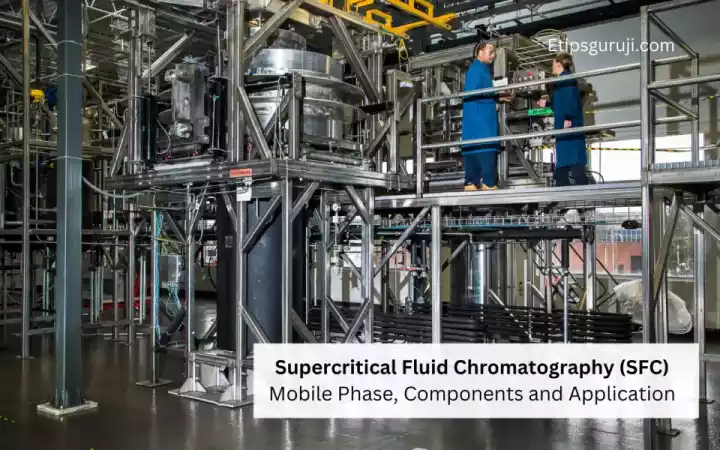Supercritical Fluid Chromatography (SFC): Mobile Phase, Components and Application

Supercritical Fluid Chromatography (SFC) is an innovative separation technique that has gained recognition for its eco-friendly nature and numerous advantages.
SFC is a physical separation method based on the interaction between an analyte in a mobile phase and a stationary phase. During a chromatographic run, one or both parameters, i.e., pressure and temperature, extend into the critical region.
The use of supercritical fluids as the mobile phase allows for the separation of analytes with chromatographic columns, resulting in:
- Solvating powers similar to organic solvents
- Higher diffusivities
- Lower viscosity
- Lower surface tension
SFC Vs Other Chromatographic Techniques
1. Liquid-like solubility: SFC provides liquid-like solubility and the ability to use nonselective gas-phase detectors, like the flame ionization detector. This makes it suitable for analyzing analytes that cannot be vaporized for GC or detected sensitively with liquid chromatography detectors.
2. Rapid separations: SFC allows for faster separations compared to HPLC, without the need for organic solvents. As an environmentally conscious technology, SFC can reduce the use of organic chemicals typically required in HPLC.
3. No new chemicals: SFC generally uses carbon dioxide (CO2) collected as a byproduct of other chemical reactions or directly from the atmosphere, so it contributes no new chemicals to the environment.
4. Lower temperature operation: Compared to GC, capillary SFC can provide high-resolution chromatography at much lower temperatures, enabling fast analysis of thermolabile compounds.
5. Use of nonselective gas-phase detector: SFC allows the use of nonselective gas-phase detectors, such as flame ionization detectors, enabling the separation and detection of analytes that cannot be vaporized or lack functional groups for sensitive detection in other techniques.
Supercritical Fluid Chromatography Mobile Phase
A. Solvating powers
Supercritical fluids offer solvating powers similar to organic solvents, making them ideal for use as the mobile phase in chromatographic separations.
Their solvating power can be adjusted by changing the pressure, allowing for more precise control over the separation process.
B. Properties
Supercritical fluids possess several properties that make them suitable as mobile phases in SFC:
- Higher diffusivities: Supercritical fluids have higher diffusivities compared to liquids, which results in faster separation times.
- Lower viscosity: The lower viscosity of supercritical fluids enables higher flow rates compared to liquid chromatography, further speeding up the separation process.
- Lower surface tension: Supercritical fluids have lower surface tension than liquids, which can improve the interactions between the mobile phase and the stationary phase during chromatography.
Conditions for true SFC definition
To truly define SFC, three conditions must be met:
- The mobile phase must always be at temperatures and pressures near or above their critical point.
- Mobile phase must possess solvating power and contribute to selectivity in the chromatographic process.
- Ir must be subject to these conditions throughout the full length of the analytical column.
SFC Components
A supercritical fluid extractor typically consists of the following components:
- Fluid reservoir: A tank containing the mobile phase, usually carbon dioxide (CO2).
- Pump: Pressurizes the supercritical fluid to reach the desired extraction pressure.
- Extraction vessel: Houses the sample and allows contact with the supercritical fluid for extraction.
- Oven: Maintains the temperature within the extraction vessel.
- Restrictor: Controls the pressure and flow rate of the supercritical fluid exiting the extraction vessel.
- Trapping vessel: Collects the extracted compounds as the supercritical fluid is depressurized and returned to a gaseous state.
SFC Extraction Modes
1. Dynamic mode: This method involves a continuous flow of supercritical fluid through the sample, dissolving and carrying target compounds to the trapping vessel. It’s an ideal choice for volatile and semi-volatile compounds.
2. Static mode: In this approach, the supercritical fluid is held within the extraction vessel for a predetermined time, allowing solutes to dissolve. Once complete, the fluid is drained, and extracted compounds are collected. This mode is perfect for non-volatile compounds or materials sensitive to dynamic extraction.
3. Combination mode: This mode incorporates both static and dynamic extraction techniques. The sample is first exposed to the supercritical fluid in static mode, followed by dynamic extraction. This method ensures complete recovery of target compounds while improving efficiency.
Read More: Photometers: Types, Filters, and Applications
Coupling Extraction Methods with SFC
A. Column types: open tubular and packed
SFC can be divided into two categories based on column type: open tubular and packed. The choice of column type is influenced by factors such as sample capacity, resolving power, and system constraints.
B. Differences in column pressure drop and volumetric flow
The differences in column pressure drop and volumetric flow between open tubular and packed columns impose different constraints on the system, affecting factors like speed and resolution.
Application of Supercritical fluid extraction (SFE)
- Food industry: Decaffeination of coffee and tea, extraction of essential oils and flavors, and production of nutraceuticals.
- Pharmaceutical industry: Extraction of active pharmaceutical ingredients, purification of drugs, and separation of chiral compounds.
- Environmental industry: Soil remediation, removal of organic pollutants from wastewater, and air sampling.
- Cosmetics industry: Extraction of fragrances, antioxidants, and bioactive compounds from botanicals.
- Polymer industry: Removal of residual monomers, additives, and contaminants from polymers.
References:
- Handbook of Advanced Chromatography/Mass Spectrometry Techniques by Michal Holčapek, William Craig Byrdwell, and Petr Jandera [Science Direct]
- Chromatography: Principles and Instrumentation by A. Braithwaite and F. J. Smith.
- Chromatography: Concepts and Contrasts by James M. Miller and Jane C. Miller
- Supercritical Fluid Chromatography with Packed Columns: Techniques and Applications by Gerard D. F. David and Joseph A. Kost
